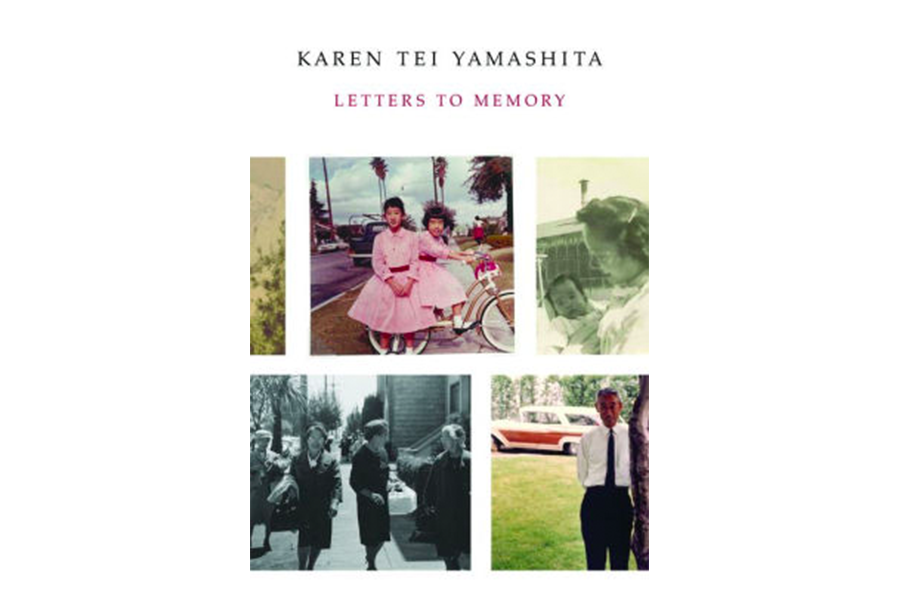'Letters to Memory' tells the story of author Karen Tei Yamashita's World War II internment
Loading...
“I have no formed definition of this project except an intuition that you would listen and be attentive and somehow understand,” Karen Tei Yamashita writes in Letters to Memory, her sagacious follow-up to her 2010 National Book Award finalist, “I Hotel.” Having built her significant literary reputation on eschewing conventional formats and easy labels, “Letters” is no different. Even her “memory” is made “wary [by her self-proclaimed] propensity for dishonesty or, as you say more kindly, fictionalizing.”
Categorized as “nonfiction/memoir” on the book’s back cover and enhanced with black-and-white photographic documentation, here’s what we know: Yamashita’s extended family, including her paternal grandmother and her seven adult children, were among the 110,000 Americans of Japanese descent imprisoned during World War II because of their heritage. Designated the family’s “useful repository” – as writer and therefore de facto archivist – Yamashita has amassed “a lifetime of stuff” in multiples, collected as the “Yamashita Family Archives” at the University of California, Santa Cruz, where Yamashita is a literature professor. With the passing of all seven Yamashita nisei (second generation), including her father John, Yamashita has “extracted a sliver of this record to ponder some questions,” she explains in her “To Begin”-introduction. “I admit mine is a different or particular way of reading and seeing our story... Reader – gentle, critical, or however, I count on you, as another guide through this labyrinth.”
Parsed into five main sections, Yamashita writes her “Letters To ...” Poverty, Modernity, Love, Death, and Laughter – each addressed to “epistolary muses”: respectively in order, they are Homer (Iliad), Ishi (the last member of the Yahi tribe, but also the Japanese word for ‘stone’), Vyasa (The Mahabharata), Ananda (Buddha’s cousin and disciple), and Qohelet (Ecclesiastes). Yamashita clearly has an agenda: she aligns each letter-topic with a specific muse, to whom she reveals a corresponding part of her family’s story, then moves beyond personal details to illuminate a broader, contemporary context such as, say, today’s civil rights.
Take, for example, “Letters to Poverty,” addressed to Homer, in which Yamashita introduces her family’s World War II incarceration. “Poverty came to be understood as a lack of justice,” Yamashita clarifies, as she explains how her “father and his family lost their freedom” on April 30, 1942, herded into Northern California’s Tanforan Racetrack before forced “wartime removal” to Topaz War Relocation Center in Utah. While the family is imprisoned, sixth sibling Kay – accompanied by her mother (Yamashita’s grandmother), Tomi – is summoned to Washington, D.C. to “testify on behalf of the United States” in a treason case against David Warren Ryder, who was a last-minute substitute speaker for a 1940 University of California, Berkeley campus meeting hosted by the Nisei Student Women’s Club of which Kay was president. “What, for me, is tragicomic,” Yamashita marvels at the astonishing levels of irony, “is that Kay, a non-alien citizen, and her enemy alien mother, whose entire people had been incarcerated for alleged possible treason, were permitted free passage to testify against others for treasonable acts.”
Yamashita chooses Homer as her empathic audience for his familiarity with war, relocation, loss of home and country. Beyond expected accusation and condemnation, however, Yamashita also considers reactions that include “charity” and “forgiveness.” That the racially-targeted immigration laws which forbade naturalization for Yamashita’s immigrant grandmother seem all too familiar now, that the eliding of civil rights is very much a current looming threat, speak volumes as to Yamashita’s awareness of how fear-based, oppressive history is, 70-plus years later, repeating the same mistakes against other families, other communities, other countries.
Four more times in the sections that follow, Yamashita alchemizes her family history into broader warnings and enlightening revelations. Before she’s finished, she channels the personal once more, addressing “Dear Reader” in “To End,” in which she confesses that she thinks her almost 99-year-old late mother would have “disapproved of making this correspondence public or revealing private lives to others, and yet they contain a history that profoundly contained her.” Yamashita’s last words – in a moment of ironic, almost petulant agency – are addressed to “Dear Editor” in “And Finally,” in which she argues, laments, and begrudgingly accepts what her editor did “to make the book in its entirety work.” In a moment of self-mocking awareness, she reminds herself, “I’m a grown-up writer. I’m breathing.”
Allusive, quirky, questioning, "Letters" is a challenging text; for all its brevity, the less-than-200 pages are dense with assumptions of cultural literacy, community insight, historical background. And yes, don’t be deterred: for “gentle, critical, or however” readers ready for intellectual stimulation, "Letters" awaits your inquisitive participation and rewarding collaboration.
Terry Hong writes BookDragon, a book blog for the Smithsonian Asian Pacific American Center.








